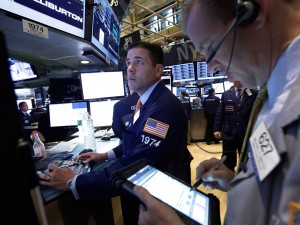
In this Thursday, June 20, 2013 photo, specialist Stephen Ruiz, left, and trader Michael Smyth work on the floor of the New York Stock Exchange. Wall Street got back to focusing on the economy instead of the Federal Reserve on Tuesday, sending stocks higher. AP/RICHARD DREW
NEW YORK—Wall Street got back to focusing on the economy instead of the Federal Reserve on Tuesday, sending stocks higher.
Four reports showed a brightening US economy. Housing and manufacturing continued to improve, and consumer confidence hit its highest level in 5 1/2 years.
The major US stock indexes closed higher, with the Dow Jones industrial average shooting up 100.75 points, or 0.7 percent, to 14,760.31. The Standard & Poor’s index rose 14.94 points, or 1 percent, to 1,588.03.
The triple-digit rise in the Dow continues a bout of market volatility caused by investors and traders who are worried about the Fed ending its economic stimulus. Last Wednesday, Fed Chairman Ben Bernanke said he expects the Fed to end its bond buying by the middle of 2014 if it feels the economy can manage without that stimulus.
The Dow then plunged by triple digits on three of the next four trading days, with investors worried that the market would struggle without the Fed propping it up.
Some investors have concluded that the recent sell-offs were overblown. Quincy Krosby, a market strategist at Prudential Financial, guessed that shorter-term traders were the ones buying stocks Tuesday because they judged that parts of the market were “oversold.”
Long-term investors are likely still sitting on the sidelines, waiting for further signs that markets are becoming less volatile, she said.
Among the biggest gainers were big dividend payers like phone and power companies. These are stocks that have been hit the hardest by the recent sell-off.
The big economic reports Tuesday revealed:
—Orders for durable goods rose 3.6 percent in May, matching April’s gain. The gauge is important because U.S. manufacturing has generally struggled this year as demand for American exports slows in other parts of the world.
—Home prices rose 2.5 percent in April compared with March, the biggest month-over-month gain since 2000, according to the S&P/Case-Shiller index of 20 cities.
— The Conference Board’s consumer confidence index jumped to 81.4 in June, the best reading since January 2008. The May reading, however, was revised down to 74.3 from the original estimate of 76.2.
— Sales of new homes rose in May to a seasonally adjusted annual rate of 476,000, the Commerce Department said. That was the fastest pace since July 2008. Though sales of new homes remain below the 700,000 annual rate that most economists consider healthy, the pace has jumped 29 percent from a year ago.
Ben Schwartz, chief market strategist at Lightspeed Financial in Chicago, described Tuesday as a day for the market to stabilize after the recent big plunges. But he predicted that the market could be volatile for the rest of the year, and others said they thought the stock indexes had already reached their high points.
The fact that the second quarter ends on Friday will also likely complicate the market’s performance this week. Money managers may pull out because they need to book gains for clients.
The stronger economic news for the US led investors to sell US government bonds, a sign that they’re more comfortable putting money in stocks. The yield on the 10-year Treasury note, a benchmark for many types of loans, rose to 2.6 percent from 2.54 percent late Monday. That’s part of a longer-term trend: Investors have been selling bonds in anticipation of the Fed winding down its bond-buying program.
The price of gold slipped $2 to $1,275.10 an ounce, and the price of crude oil rose 14 cents to $95.32 a barrel.
Among stocks making big moves:
—Walgreen, the nation’s largest drugstore chain, slipped after reporting earnings and revenue that missed analysts’ expectations. Walgreen’s stock fell $2.83, or nearly 6 percent, to $45.22.
—Barnes & Noble plunged after reporting a loss that more than doubled in the latest quarter. The bookseller struggled to compete with online retailers and its Nook e-book continued to lose money. The stock fell $3.21, or more than 17 percent, to $15.61.
—Clothing chain Men’s Wearhouse rose after saying it had fired executive chairman George Zimmer, the company’s founder and star of its TV commercials, because he had advocated for “significant changes that would enable him to regain control,” according to the company. The stock rose $2, or nearly 6 percent, to $37.13.—Christina Rexrode